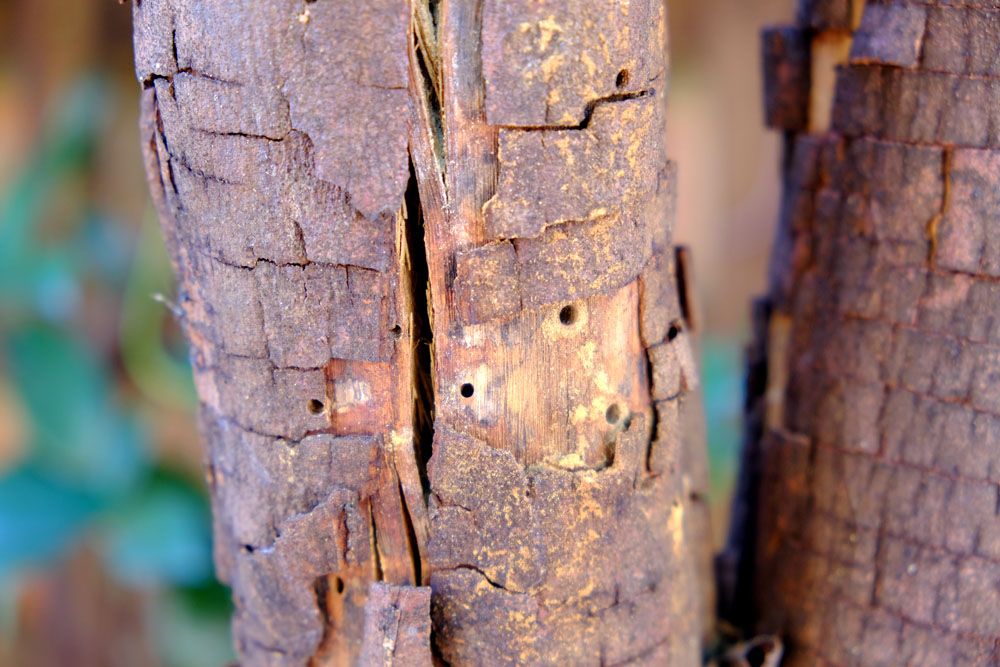
Borers
Borers
Several insects mature by digging through the branches, trunks, or roots of trees and plants somehow. Wood borers, which include numerous beetles, moths, and an unusual family of wood-boring wasps, account for most of these (horntails).
Common Types of Tree Boring Insects:
The kinds of borer that may attack your trees determine where you live in the United States. Different kinds of wood-boring insects attack different types of trees and shrubs, so your plants may be more susceptible to some borers than others. The following are some of the most prevalent types of wood borers:
Flat-headed wood borers: are sometimes known as jewel beetles or metallic wood-boring beetles because of their flat heads. These big beetle family preys on stressed or newly transplanted plants. These borers have distinct metallic hues and a boat-like form as adults, and their larvae have a similar flat appearance. When the larvae dig into wood, they make oval or flattened holes due to their body shape. These insects’ tunnels may wrap tree trunks and branches, placing trees in grave danger.
Weevils: Unlike borers, which bore into wood to produce galleries or tunnels, weevil larvae burrow hollowed-out holes or cells beneath the bark. Weevils attack the roots and bases of woody ornamental plants in a variety of ways.
Caterpillars of the wood-boring moth: often known as clearwing borers because of their adult form as clearwing moths, hatch in tree bark after an adult lays eggs there. After hatching, they quickly burrow through the bark to feast on the wood. Insecticide sprays will have little effect once the larvae have tunneled into the wood. Clearwing moths are attracted to stressed or injured trees because of their chemicals used as egg-laying sites.
Longhorn beetles (round-headed borers): Round-headed borers are long-horned beetles with antennae that can be longer than their bodies. Round-headed borers’ larvae have a round form and leave a round or oval tunnel behind them. The majority of the round-headed borer insects are secondary intruders.
Life Cycle:
The timing of life phases varies by borer species, location, and environmental circumstances, but all borers. A tree infected with the round-headed borer will frequently have dust-like frass (excrement) or sap on the trunk and branches.go through four phases of development: egg, larva, pupa, and adult egg, larva, pupa, and adult.
When adults are mating on or near the host plant, eggs are laid. On or under bark, in leaf litter/detritus on the ground, and crevices in tree trunks or branches are all familiar egg-laying places.
Larvae – After hatching, the larvae penetrate the host plant and begin to eat.
Pupae – Some borers’ pupal stage in or on their host plant, while others pupate in the soil. During this time, no harm is done.
Adults – After emerging from their pupae, adults mate and look for the best places to lay their eggs.
Damage:
Borer diseases are generally undetected until plants or sections of plants die or exhibit damage symptoms outside. Frass is a sawdust-like substance produced by wood-boring insects (excrement). Their holes are usually round, oval, or semicircular, and they are arranged in a random pattern on the plant. Woodpecker damage is sometimes mistaken for that of wood-boring beetles. However, woodpecker damage does not create frass. The yellow-bellied sapsucker, for example, makes square holes in rows around a trunk or branch. Borers penetrate through the inner bark layer (cambium), transporting nutrients and water to the leaves. The plant finally dies above or beyond the injury location when the cambium layer is entirely girdled. Plant growth and vitality above the assault site are reduced by partial girdling. Tunneling can sometimes weaken the tree, causing branches and leaves to collapse. Borer damage can degrade the quality of wood and make trees more prone to disease.
How to get rid of Borers:
If your tree is infested with wood borers, you have two options for getting rid of them:
Chemical: Contact insecticide and soil treatment can be used to kill active borers and prevent new infestations, depending on the type of borer infesting your tree. Every state has its pesticide regulations, so check if you can use a pesticide lawfully before using it on your trees.
Mechanical: Other than using pesticides, mechanical management techniques include removing the larvae from the tree with a tool or removing infested wood. If the infection is severe, you may need to remove the entire tree to avoid the risk of falling branches.
Prevention of Tree Borer:
- The best method to deal with a wood borer infestation is to prevent it from starting in the first place. Consider the following approaches for avoiding tree borers:
- Proper tree care includes: Borers prefer fragile or stressed trees; therefore, adequate watering and fertilization procedures can reduce the likelihood of infection. Remember to keep an eye on newly transplanted trees that are more susceptible to stress.
- Selecting the Correct Tree Species: When planting new trees, choose species that aren’t commonly attacked by wood borers in your region. Research the less sensitive trees in your area and concentrate on them rather than the more fragile ones.
- Tree injury prevention and care: Tools such as mowers can cause external damage to a tree, making it subject to borer infestation. If you accidentally hurt a tree, treat the wounds with pruning or wound paint as soon as possible.
